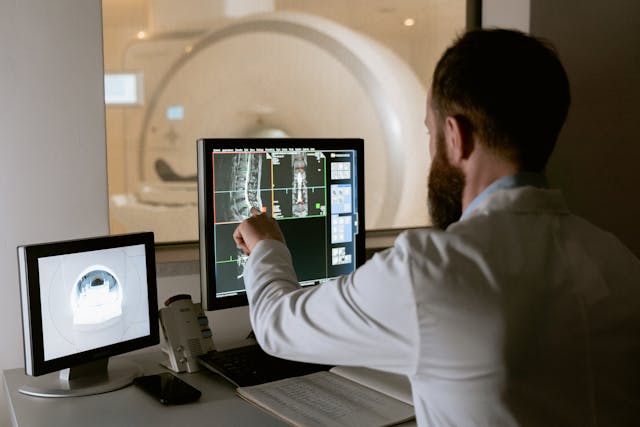Introduction
Rapid-fire changes in healthcare demand equally swift solutions – and that’s exactly where technology comes in, shouldering the load with remarkable agility. Fast-forward to the classroom of tomorrow, where medical students are no longer confined to static textbooks or one-size-fits-all instruction. When advanced technologies converge with healthcare expertise, remarkable things happen – barriers dissolve, fresh ideas flourish, and professionals forge new pathways to transform patient care, tackling the intricate puzzles of a dynamic healthcare landscape with confidence and authority. What if healthcare education could be faster, smarter, and more effective? Imagine a world where technology, healthcare, and education converge – that’s the new reality we’re experiencing, where digital innovations are rewriting the rules of medicine.
Image via Pexels
The Evolution of Technology in Healthcare Education
The Impact of the COVID-19 Pandemic
The COVID-19 pandemic unexpectedly propelled the healthcare education sector into the digital age. What happens when the familiar landscape of traditional classrooms gets rewritten overnight? As change-makers, educators and institutions step up, innovating the way we learn, driven by an insatiable curiosity to find new ways to reach and inspire students. What was once a static, instructor-led approach to healthcare education has given way to a flexible, tech-driven model that allows learners to engage with material in a way that’s personal, interactive, and highly effective.
Key Technologies Revolutionizing Healthcare Education
Online Distance Learning
Online distance learning has become a cornerstone of healthcare education. Imagine having access to top-notch educational materials, face-to-face interactions with instructors, and peer connections from anywhere on the planet. That’s exactly what platforms like Learning Management Systems, video conferencing, and webinars offer students today. No matter what’s happening outside, this flexibility keeps education on track, uninterrupted.
Virtual Reality (VR) and Augmented Reality (AR)
Virtual and augmented reality technologies have transformed healthcare education. Clinical skills don’t develop in a vacuum, so students love using these lifelike simulation tools to hone their craft in a stress-free environment. Thanks to VR and AR advancements, surgeons who used to worry about “killing” digital patients can now perfect their skills in a lifelike environment.
Wearable Technology
Wearable devices, such as smartwatches and fitness trackers, play a significant role in healthcare education. Students get real-world experience with the devices that monitor vital signs and track health metrics – the same ones they’ll rely on in their future careers. Data from wearables gets crunched in real-time, turning it into instant feedback that supercharges the learning process.
Mobile and Portable Technology
Imagine having the entirety of medical knowledge at your fingertips – that’s the reality for healthcare students and professionals, thanks to the proliferation of smartphones and tablets in education. Students can access electronic textbooks, medical apps, and educational videos at their convenience. On-the-go students and instructors can collaborate seamlessly with mobile devices, creating a classroom atmosphere that’s electrified with possibility.
Computer-Assisted Learning (CAL)
Imagine learning that’s engaging, interactive, and effective – that’s what computer-assisted learning is all about, actively encouraging students to participate and learn. What if students could bring theory to life? That’s exactly what happens when they engage with interactive quizzes, simulations, and virtual labs – actively applying their knowledge in practical, real-world settings. By tackling the whole person, not just the lesson plan, CAL creates a learning environment that seamlessly merges fun and academic rigor, acknowledging that every student learns differently.
Technology in Radiology Schools
Healthcare education is revolutionized when technology takes center stage, as exemplified by radiology schools. In radiology training, digital X-rays, MRI, and CT scans are the go-to tools for diagnostic clarity. They’re the pillars that support confident decision-making. By putting students in the driver’s seat with innovative medical imaging tools, they’re able to unpick the intricacies of human anatomy, spotting patterns and subtleties that would otherwise go unseen – the perfect prep for a career in medical excellence. Practice makes perfect, and with virtual simulations of radiological procedures, students get to hone their skills in a safe space before entering the high-stakes world of real-world clinical settings. Radiology education takes a major leap forward when Picture Archiving and Communication Systems (PACS) are integrated, facilitating the seamless exchange and analysis of medical images. This collaborative approach fuels critical thinking and sharpens diagnostic skills.
Benefits of Incorporating Technology in Healthcare Education
Enhanced Learning and Feedback
Imagine learning environments where virtual labs, video conferencing, and interactive software come together in perfect harmony. With technology, educators can craft dynamic, inclusive, and highly engaging experiences that students won’t soon forget. Engaging, interactive elements – think virtual simulations, quizzes, and videos – foster active learning, empowering learners to reflect on their progress with timely feedback. What if teachers could pinpoint exactly where each student needed extra help? With data analytics and AI on their side, educators can create flexible learning pathways that meet students where they are.
Improved Visualization of Clinical Settings
Virtual and augmented reality technologies offer students a realistic and immersive experience of clinical environments. This allows them to visualize complex medical procedures and scenarios, leading to a deeper understanding of the material. The ability to repeatedly practice these scenarios in a risk-free setting builds confidence and competence.
Patient Safety and Reduced Risk
One of the significant advantages of using technology in healthcare education is the ability to simulate patient interactions and procedures. This ensures that students can practice and refine their skills without putting real patients at risk. By learning from their mistakes in a controlled environment, students become more proficient and confident in their abilities.
Replicable and Customizable Learning Scenarios
Technology allows educators to create repeatable and customizable learning scenarios. This flexibility enables students to practice different approaches and techniques, enhancing their critical thinking and problem-solving skills. It also prepares them for the ever-evolving nature of the healthcare field, where adaptability is crucial.
Personalized Learning Experience
Adaptive learning platforms and intelligent tutoring systems personalize each student’s educational experience. These technologies adjust the content and pace of instruction based on individual progress and needs, increasing student engagement and improving learning outcomes.
Best Practices for Integrating Technology in Healthcare Education
Curriculum Alignment
Before introducing new technologies, it is essential to evaluate and align the existing curriculum with technological capabilities. Redesigning lessons, creating new learning activities, and integrating technology-based assessments ensure a seamless integration that maximizes the impact of technology on learning.
Training and Support
Adequate training and support for both teachers and students are crucial for the effective use of new technologies. Professional development workshops, online tutorials, and peer mentoring programs can help build competence and confidence. Encouraging experimentation and risk-taking fosters a supportive environment for technological innovation.
Continuous Evaluation
Assessing the effects of technology on learning outcomes regularly helps education stay on track. Instructor insights are informed by surveys, observational research, and a crisp analysis of student performance. From there, we can refine our tech strategy and tackle any roadblocks that come up.
Open Education Repositories
Developing open education repositories makes sharing high-quality educational resources possible. This makes access to valuable learning materials far more convenient. When educators team up, they can confidently provide learners with fresh, relevant content that meets their needs. What if teachers could spend more time instilling wonder in their students and less time crafting lessons from scratch? This approach makes that a reality.
Conclusion
The lines between healthcare and technology are blurring fast. Learning and interacting just got a whole lot more exciting – and it’s all thanks to the remarkable fusion of forces at play here. Learning shouldn’t feel like a distant dream. Teachers who tap into technology’s potential can kindle a fire in health professionals, bridging the gap between abstract concepts, practical skills, and a deeper understanding that sticks long after the lesson is over. When educators merge technology with healthcare instruction, the result is a more immersive, interactive learning experience. What happens when these pieces come together? Students graduate as self-assured, highly competent healthcare professionals, and patient outcomes flourish as a result. The horizon of healthcare education is looking sunnier by the day.






